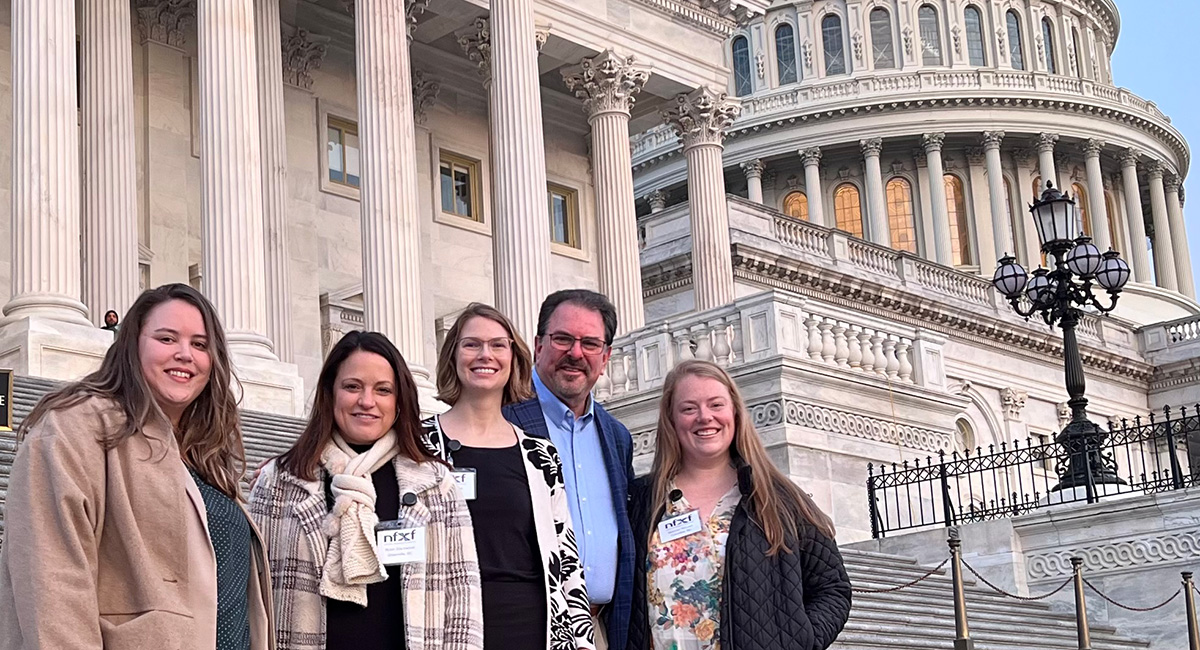
Two decades ago, experts did not think fragile X carriers could have symptoms.
Since then, research has revealed that mothers of children with fragile X who carry the FMR1 premutation are at risk for cognitive and physical health problems, which can be exacerbated by the stress of caregiving.
“We've started to learn there are these specific symptoms or problems that carriers have,” says Jessica Klusek, director of the South Carolina Family Experiences Lab. “That's kind of a new understanding.”
Fragile X syndrome is the most common inherited genetic cause of intellectual disability and autism. It stems from a gene mutation on the X chromosome. There is no known cure or specific treatment. The FMR1 premutation is the genetic mutation found in women who are carriers of fragile X syndrome.
Klusek, a USC associate professor of communication sciences and disorders at the Arnold School of Public Health, has been studying and advocating for children and families affected by fragile X syndrome for many years.
She and her team at the SC Family Experiences Lab are now collecting data on women in demographics who really haven’t been studied previously, hoping to gain a better understanding on age-related decline among women who carry the FMR1 premutation and whose children are diagnosed with fragile X syndrome.
Overlooked no longer
Klusek says there are reasons why women have been underrepresented in fragile X research.
“A lot of the research on aging in the fragile X premutation has just focused on men,” she says. “I’m definitely getting more interested in fragile X premutation carriers, which in my program of research is specifically focused on women who are carriers.”
The adult-onset disease of the nervous system that is known to affect carriers is Fragile X-associated Tremor/Ataxia Syndrome. FXTAS is linked to neurological signs such as tremors and balance problems. While men who are carriers are more likely to show signs of it than women, Klusek estimates that it affects about 15 percent of women.
In the United States, about one in 450 men and one in 150 women are carriers of the FMR1 premutation. Apply those rates to South Carolina, and one would expect about 24,000 carriers across the state.
For FXTAS, Klusek sees a history of how clinicians and the research field have framed their expectations. “It's kind of like, ‘Oh, women don't get that,’ or ‘It's really unlikely.’ Even though it's about a 15 percent chance that a woman with the FMR1 premutation will develop FXTAS, which is not good odds.”
“We see that women carriers put a lot of focus on their kids and have less bandwidth to pay attention to their own health.”
The way FXTAS was originally defined as a neurodegenerative disease, the criteria was largely based on how it presented in men. “And it was a very stringent criteria,” Klusek says. “A lot of women that we’re seeing aren’t going to meet that criteria just because symptoms present differently. Women are different than men, so we need more research on how these age-related problems manifest in women.”
It goes along with the countless health scenarios where conditions present differently depending on gender. “For instance, when women have a heart attack, it looks different than it does in men. But that doesn't mean we shouldn't recognize it and treat it,” Klusek says. “There is a need specifically to study women who are carriers to understand, ‘What does aging look like in female carriers?’”
‘Missing the part of the lifespan’
Most of what is known about women as carriers arrives from studies that were focused on children with fragile X syndrome. In many cases, the caregiver – who is most often the mother – would participate as a measure of family environment. But the mother was not the focus of the research.
“Early research focused on women carriers who were about 35 to 55 years in age and were participating in research focused on their children. So we know more about female carriers during this middle-age period,” Klusek says. “But since there seems to be an age-related component to the premutation, we're kind of missing the part of the lifespan where we think that there is probably going to be the most involvement.”
When children with disabilities reach adult age, they can still be living at home and being cared for by their parents, with the mother often the primary caregiver.
“We see that women carriers put a lot of focus on their kids and have less bandwidth to pay attention to their own health,” Klusek says. “They're also often not being guided by their medical providers, who are not as knowledgeable about the FMR1 premutation.”
One specific condition researchers are seeing is called Fragile X-associated Primary Ovarian Insufficiency (FXPOI). It affects about a fifth of female carriers, causing early menopause and fertility problems.
Women who carry the FMR1 premutation are also more likely to struggle with depression and anxiety, migraine and chronic pain conditions, and have autoimmune disorders such as thyroid disease and fibromyalgia. As Klusek spends time with them, she sees women who are glad that researchers are finally paying attention to their symptoms.
“They're like, ‘This is great! Study me!’” Klusek says. “So, that feels meaningful.”
Researchers see this level of interest as a sign that a study is going well. It shows that the research is perceived as valuable by the population it was intended to serve.
“Because there's so little research on aging in women who carry the FMR1 premutation, I don't think they're necessarily getting good clinical care,” Klusek says. “Which makes sense, because there's nothing to guide practitioners and no information on questions such as who's at risk and what can we do to protect against risk.”
Klusek also works to advocate on behalf of families affected by fragile X syndrome, appearing annually at the State House in Columbia as part of South Carolina Fragile X Awareness Day. At the end of February, she and her team visited Washington and the Capitol to join the National Fragile X Foundation for NFXF Advocacy Day.
Part of the message now is a need to revisit a female presentation of age-related conditions related to the premutation. With so much unknown about fragile X-associated conditions, that means there are gaps in how many people are affected.
“We need more research to guide this population and to guide health care professionals,” Klusek says. “That way we can raise awareness of preventative strategies and how to improve health with aging.”

“It was a great experience meeting with our South Carolina representatives and advocating for more research funding and specific legislation to improve the lives of those living with fragile X-associated conditions," Klusek says.
Banner image: By Freepik.